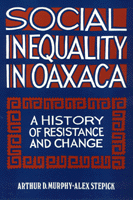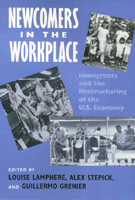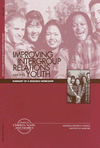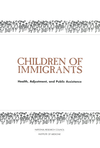ALEX STEPICK
BOOKS
Immigrant Faiths:
Transforming Religious Life in

This Land Is Your Land

Social Inequality in
Resistance & Change

http://www.temple.edu/tempress/titles/815_reg_right.html
City on the Edge: The Transformation of Miami

http://www.ucpress.edu/books/pages/6199.html
Theauthors reveal how the Cuban success story has transformed the character ofMiami while delineating more sharply the identity of other ethniccommunities." --New York Times Book Review
"Makesa case for the importance of political capital . . . in building ethnicsolidarity."--Contemporary Sociology
AWARDS
Robert E. Park Award for the best book in Urban and Community
Sociology,The American Sociological Association
See other Robert E. Park Award winners at
First winner of the Anthony Leeds Book Prize, The Society for UrbanAnthropology
Reviews of City on the Edge
From Kirkus Reviews
A perceptive appreciation of Miami andwhat
makes it tick, from a pair of sociologists who understand that
anecdotalevidence can be as illuminating as statistical abstracts. Drawing
ondemographic data, personal observations, interviews, newspaper articles,
andallied sources, Portes (Johns Hopkins Univ.) and Stepick (Florida
InternationalUniv.) profile a city in which cultural diversity is a convulsive
reality.Noting that Miami has become the Caribbean's de facto capital in the
more thanthree decades since Castro seized Cuba, the authors point out that
politicalevents, rather than economic or geographic advantages, have made Miami
aworld-class entrep"t--a reversal of the way in which America's
urbancenters usually develop. After providing a brief history of the Sunshine
Stateand its settlement, Portes and Stepick offer detailed human-scale accounts
ofthe immigrant groups that changed a sleepy winter resort into a
teemingyear-round metropolis with a Hispanic cast. Bourgeois Cubans bent on
escapingCastro's Communism were the first to arrive in force. While
restructuring theiradoptive city's socioeconomic and political institutions,
these exiles werejoined by less favored compatriots (the so-called Marielitos),
Haitians, andNicaraguans fleeing the Sandinistas. By 1990, 49.2% of greater
Miami'spopulation was Latino, up from 4.0% in 1950; by contrast, Anglos (the
localname for whites) represented but 30.3% of the total, with blacks
(native-bornor otherwise) at 19.5%. As the authors make clear, the shift in the
ethnicbalance of power has not been without serious frictions--but they
conclude that,once Castro leaves the stage, assimilation pressures could prove
stronger thanthe ties that now bind and divide Miami's disparate communities. A
municipalreport that offers clues to what could be in store for other of
America'sborder towns. A fine complement to David Rieff's The Exile (p.
773).(Illustrations) -- Copyright ©1993, Kirkus Associates, LP. All
rightsreserved. --This text refers to an out of print or unavailable
editionof this title.
Newcomers in the Workplace: Immigrants &the Restructuring of the U. S. Economy

http://www.temple.edu/tempress/titles/1230_reg.html
http://www.powells.com/cgi-bin/biblio?inkey=62-1566391318-0
AWARDS
Conrad Arensberg Award 1994, Society forthe Anthropology of Work, American Anthropological Association
Newcomers in
theWorkplace: Immigrants and the Restructing of the U.S Economy
Lamphere, Louise,
AlexStepick, and Guillermo Grenier
http://www.temple.edu/tempress/awards-socio.html
Pride Against Prejudice: Haitians in theUnited States

http://www.abacon.com/newimmigrants/
Review of Pride Against Prejudice
The story of Haitiansrecently arriving in the United States has been marked by escapes frompersecution, flights across open seas, surreptitious entries, significantracial/cultural/linguistic/religious differences from mainstream [American society, prejudice and discrimination by the larger society and byothers of color, intra-group class divisions, changes among second-generationchildren, vulnerability due to arbitrary (or perhaps quite calculated)immigration policies, and political instability in the homeland (as well as theU.S. government-sparked AIDS scare regarding Haitians). Stepick concentrates onthose elements of the story as they affect Haitians in South Florida where theyhave had to contend with hostile whites, prejudiced African Americans, and aCuban enclave and enclave economy, all of which have hampered Haitian efforts togain a secure foothold and create an effective enclave of their own. As withthe others discussed here, the "family remains the central organizinginstitution" (p. 15) and remittances continue to be "central" totheir lives, symbolizing "strong transnational psychological ties torelatives back home" (pp. 29-30). Stepick details the struggles ofHaitians to get jobs, to establish fledgling businesses with limited capital (afar cry from Wong's Chinese), to overcome the absence of an enclave economy, topersuade Americans to hire them, and to enhance their human capital (educationand skills) as well as their social capital (family and kin networks). Incontrast to the other volumes, Stepick puts a particular emphasis on thestudies of the second generation, detailing the struggles of the "justcomes" (recent arrivals) and the "cover ups." The latter,particularly in high school, strive to hide their Haitian identity and engagein "segmentary assimilation" whereby they copy the African Americans'behavior, language patterns, and culture rather than the whites' in an attemptto avoid rejection and humiliation at the hands of African American classmates.As part of that strategy they also adopt an "adversarial academicorientation" (pp. 62-67), and their school performance suffers. Incontrast, those born in Haiti and/or the children of professionals have beenmore likely to resist covering up, to pursue academic excellence, and toproudly assert their Haitian heritage. Stepick labels this response to thehostility encountered "reactive formation ethnicity" (p. 72), and itdiffers substantively from that described in the other works. South Florida'sHaitians look to the second generation to improve their own status in America.
Haitian Refugees in the United States
A close examination of the economic and social position of the Haitiancommunity
in the USA.
http://www.minorityrights.org/catalogue.asp
This short, though informational, booklet gives a brief history of Haiti andHaitian immigration into the United States, the Dominican Republic and theBahamas. It also details US policy towards Haitians. The material was veryuseful, though dated as it was published in 1986 and much has changedpolitically in Haiti since.
Miami Now!

http://www.upf.com/BIP-floridiana.html
Voices From The Welfare Vortex A
DescriptiveProfile of Urban, Low-Income African American Women on the Eve
ofDevolution 36 Volume 7
Stan L. Bowie, Carol Dutton Stepick & Alex Stepick III
Race, Gender & Class in Social Work
andPractice
Volume 7, Number 4, 2000 ISSN 1082-8354
Guest Co-Editors: Beverly Favre and Rose Wilson
The preliminary study is a longitudinal, ethnographic profile of 20welfare-reliant African American women in urban Miami who are experiencing thetransition from Aid to Families with Dependent Children (AFDC) to Temporary Aidto Needy Families (TANF). Data were collected through repeated, in-depthinterviews over an 18-month period and respondents were assessed regardingfamily patterns and history, family health status, employment experiences, incomesources, and expenditure patterns. Dominant themes from their welfare reformexperience are isolated and respondent quotations are provided regarding lifeon welfare, employment prospects and the impact of immigrants, job trainingprograms, the need to compromise self-respect and dignity for survival, andhope and family aspirations.
Latinos in the 21st Century: Mapping
theResearch Agenda
Margaret Mead Award
http://www.aaanet.org/committees/awards/awards.htm#mead
Improving Intergroup Relations Among Youth:Summary of a Research Workshop (1999)

Division
ofBehavioral and Social Sciences and Education (
Related Books
http://www.nap.edu/books/0309067928/html/index.html
Children of Immigrants:Health, Adjustment,and Public Assistance (1999)

Division
ofBehavioral and Social Sciences and Education (
http://www.nap.edu/books/0309065453/html/index.html
You can find a list of all the books by Alex Stepick at:

|
Website Designed by |
|

